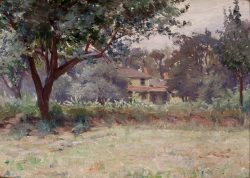Alice Kellogg Tyler, from a photograph circa 1890–1895, estate of Alice Kellogg Tyler, courtesy Williams & McCormick American Arts, Columbia, Missouri.

Alice Kellogg Tyler 1862–1900
One of six daughters of a Chicago doctor, Alice De Wolf Kellogg began her art training in 1879 at the Chicago Academy of Fine Arts (renamed the Art Institute of Chicago in 1882) and soon was assisting with instruction. She won the school’s highest prize, a certificate for three months’ tuition. Among her classmates was painter Arthur B. Davies, with whom she formed a close, perhaps romantic, relationship that ended in 1892 when he married another woman. By 1887, Kellogg was teaching at the Art Institute and painting in a shared downtown studio. That year, she departed for Europe, traveling in England and on the Continent and making copies of notable paintings in museums. In Paris she studied at the Académie Julian and the Académie Colarossi, and in the private atelier of American expatriate painter Charles Lasar. Kellogg’s letters home provide a useful record of American students’ shared experience of study in Parisian art schools in the late nineteenth century. Her French instructors, who were fashionable portrait and figure painters, recognized her talent and her works were included in the 1888 and 1889 Paris Salon exhibitions and at the Exposition Universelle of 1889. In Paris, Kellogg’s acquaintances included many leading American artists and other figures in the Chicago art community, including Lawton Parker as well as Pauline Dohn (later Rudolph), one of a group of Chicago women with whom she shared a studio and living space.
Kellogg returned to Chicago in 1889 with The Mother, a major painting that established her reputation in the U.S. It was shown in New York in the 1891 exhibition of the Society of American Artists, to which the artist was elected—the only “Westerner” and the first Chicagoan so honored. Kellogg taught classes in her studio, at Jane Addams’s Hull-House, and at the Art Institute. Active in the Palette Club, a women artists’ organization of which she served as president in 1891, 1892, and 1895, she was among the club members who contributed murals to the Illinois Building at Chicago’s 1893 World’s Columbian Exposition; there, The Mother and one of her landscape paintings were included in the important juried international art exhibition at the fair’s Palace of Fine Arts. The year after the fair, Kellogg married Orno Tyler, a Chicago businessman and amateur artist. Unlike many women artists of her day, she did not abandon professional work following her marriage; rather, it marked the beginning of her participation in the Art Institute’s annual exhibitions. When Alice Kellogg Tyler succumbed to diabetes at age thirty-seven, Chicago sculptor and art writer Lorado Taft hailed her as the “choicest spirit” of “Western art.”i
Tyler was adept in oils, watercolors, and pastel; she also made several etchings and experimented with monotype printmaking. She painted portraits and figural works as well as landscapes. In the 1890s, she was among the first Chicago artists to adopt the rapid, on-site execution, loose brushwork, and bright color and light of impressionism, which she explored in many small, intimate paintings. As these have emerged into public view since the 1980s, Tyler has received increasing recognition.
Wendy Greenhouse, PhD
i Lorado Taft, “A Memory,” Chicago Record-Herald, Feb. 14, 1901.
